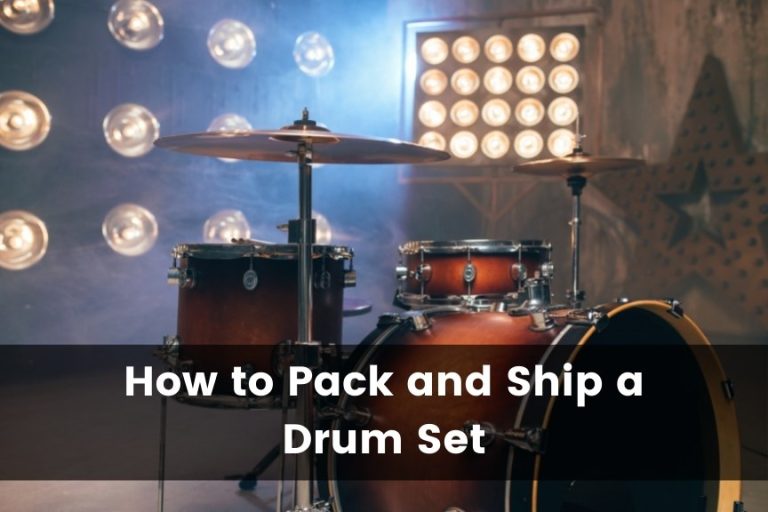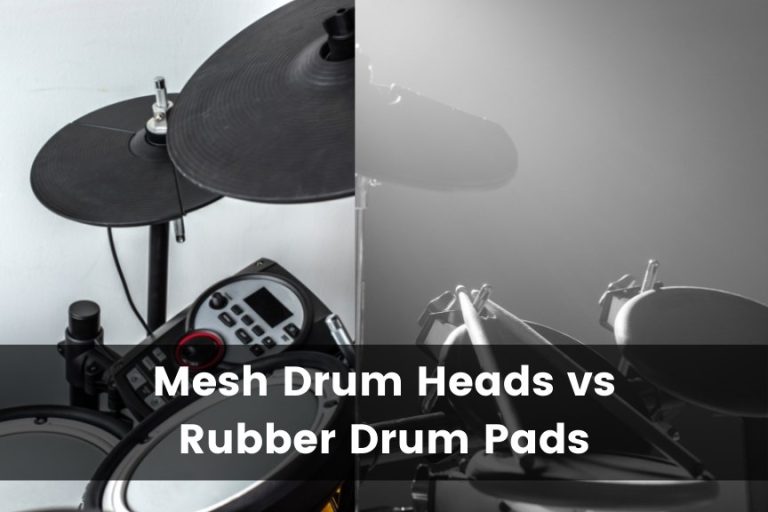How Much Does a Drum Set Weigh?
You get a couple of drummers together, and sooner or later, they’ll complain about the weight of their sets. The thing is, moving a drum set is a hassle. It consists of four or five drums, cymbals, a drum throne, and hardware. But how much does a drum set actually weigh?
5-piece drum sets weigh a minimum of 60 lbs (27.22 kg). Drum set weights vary greatly based on the number of pieces in the set and the quality of the drums, and it’s difficult to give a specific figure. There are exceptions, but lighter drums are usually either of inferior quality or expensive.
This post explains everything you need to know about drum weights, what causes some to be heavier than others, how to transport a drum kit across town or to a gig, and how to pack it for shipping.
How Much Do Drum Sets Weigh?
Drum sets weigh at least 60 to 70 pounds (27.22 to 31.75 kg). However, because of the variety in drum sets, it’s not possible to say how much drum sets really weigh.
Let’s start with a general range for a typical 5-piece set and then look at those weights in more detail.
Finding specifics on drum set weights is a challenge, and it’s not only because of variety. In most cases, manufacturers and most websites list the types and sizes of the drums, but not their weight. Or, when that information is listed, it’s not easy to find.
Ironic, since drum weight is an important piece of information—especially if you need to carry your set to a gig or a friend’s house, or it needs to be shipped.
Based on the available numbers, we can start with a range of 60 to 70 pounds (27.22 to 31.75 kg) as a baseline for a 5-piece set. This assumes the following minimum weights:
| Drum | Minimum Weight |
| Snare | 10 |
| Bass | 15 |
| Toms (2) | 30 (15 each) |
| Cymbals (3) | 6 |
| Drum Stool | 5 |
A drum set’s weight can also be broken down into to categories: travel drums and full-size sets.
A travel drum kit is designed to be transported from gig to gig. As a result, many of its components are lightweight. Manufacturers of portable drum kits must reduce the weight of the drums without sacrificing sound quality.
Full-size sets are built with performance in mind rather than size or weight. The materials used for shells, like mahogany, are chosen for their tone instead of their portability.
What Are the Weights of Individual Drums?
It’s impossible to determine the individual weight of each drum on any drumset. Their weights can vary widely. For example:
- Snare drums can weigh from 4 to 8.6 pounds. (1.8 to 3.9 kg)
- Hi-hats can weigh from 4.2 to 2 pounds. (0.9 to 1.9 kg)
- Chairs can weigh from 4 to 13 pounds. (1.8 kg to 6 kg)
- Stands can weigh from 21 to 46 pounds. (9.5 to 21 kg)
Here are some examples of drums available on Amazon.com that illustrate the problem of coming up with a single weight:
- Snare drums. A Yamaha Stage Custom Birch weighs 8.6 pounds (3.90 kg), while a MAPEX Maple Snare Drum weighs 4 pounds (1.81 kg).
- Hi-Hats. Zildjian Custom Hybrid Hi-Hats weigh 4.2 pounds (1.91 kg), while Paiste Signature Dark Crisp Hi-Hats weigh only 1.98 pounds (0.90 kg).
- Chair (throne). Chair weight can range from 4 pounds (1.81 kg) for the PDP By DW Drum Throne to a 13.2 pound (6 kg) Donner Adjustable Drum Throne.
- Racks and stands. Even the hardware weights vary greatly. For example, a Gibraltar GCS-450C weighs 45.7 pounds (20.7 kg), while the Pearl 3-Sided Rack is much lighter at 21 pounds (9.53 kg).
What Affects Drum Weight?
Both size and material affect how much a drum set will weigh. For example, a 5-piece acrylic set can weigh 70 lbs (31.75 kg), while other sets can weigh close to 100 pounds (45.36 kg). The type of wood and hardware are two of the most significant contributing factors.
For example, the acrylic Ludwig Vistalite John Bonham Zep Set weighs 70 pounds (31.75 kg) and has a bass drum, two toms, a snare, a high hat, and cymbals. But the light weight comes with a heavy price tag—over $3000 dollars!
Wood Weights
Drum shells are commonly made from birch, beech, maple, and oak. It would seem simple enough to compare the weight of those four varieties—except there isn’t a single variety of birch, beech, maple, or oak.
According to the United States Forest Service, these are the weights of those four varieties. Each weight is pounds per air-dried cubic foot:
- Birch: 35-46 lbs (16-21 kg)
- Beech: 45-48 lbs (20-22 kg)
- Maple: 32-44 lbs (15-20 kg)
- Oak: 40-51 lbs (18-23 kg)
Another complication is that drums shells can be made from different types of plywood glued together, from six-ply to ten-ply.
For example, three pieces of two-ply plywood are chosen for a six-ply tom-tom. Because the inner shell components’ circumferences are shorter, each length is shorter.
The adhesive then adds additional weight. The wood is molded after a strong adhesive is applied on one side of the exterior and interior boards, and on both sides of the middle panel.
To save money, some manufacturers use thinner plywood. Unfortunately, this increases the wood to glue ratio.
When drum shells are molded, they’re dried in a microwave. If the shells were dried in a heater, the adhesive and wood would be heated as well, which would ruin it. But since microwaves only heat water, the wood and glue aren’t harmed.
The Hardware Components Also Affect a Drum’s Weight
Steel is commonly used for the many hardware components that hold the drum together. However, other metals, such as brass or aluminum, are occasionally utilized. In addition, these components are sometimes constructed of wood or rigid plastic.
Aluminum weighs a third as much as steel, so if you’re looking for lighter drums, check out the materials used in the hardware.
Do Electric Drum Sets Weigh Less?
Electric drum sets weigh less than normal drum sets, but not as little as you might expect. The main reasons are their hardware electric drums are solid and have less air space.
Here are the weights of several electric drum sets available on Amazon.com:
- LyxJam Electronic Drum Kit. An 8-piece drum set that weighs 47.2 pounds (21.41 kg). Remember, however, that if you want to be heard on stage or jamming with your friends, you need an amplifier.
- Roland TD-1DMK Dual-Mesh Kit. Includes kick, snare, hi-hat with control pedal, tom x 3, crash, ride, and drum stand. It weighs 54 pounds (24.49 kg)
- Alesis Drums Nitro Mesh Kit. An 8-piece kit with an 8 inch (20.32 cm) dual-zone snare pad, (3) 8 inch (20 cm) tom pads, and 3 10-inch (25.4 cm) cymbals.
If you need to go as lightweight as possible, the AeroBand Air Electronic Drum Set weighs around 6 ounces (0.03 kg). It includes two sticks, several sensors, and USB cords to connect the air drumsticks to your device. If you ever wanted to play air drums, here’s your chance.
Ultimately, electronic drum kits are simpler to set up and much more portable. Not only do they weigh less, but they take less space. Ask any drummer, and they’ll complain about the bulkiness of the drums as much as the weight.
How Can I Move My Drum Kit to a Gig?
Here are some tips for moving a drum kit to a gig:
- Take only what you need.
- Practice loading your gear.
- Prepare for the setup.
No one envies a drummer having to take their kit to a gig. Having some strategies in place can lessen, though not eliminate, the hassle. A little planning and practice can go a long way.
- Take only what you need. Your playing might be essential, but the audience is there for the whole band and won’t know what you left at home.
- Practice loading your gear. Determine how to best arrange your drums. You want to maximize space while giving the driver visibility. Don’t wait until the day of your first gig to experiment with different setups.
- Prepare for the setup. If it’s a new venue, check it out or find someone who has played in it. Memory collars for cymbals and tom angles can speed up your setup. A drum rug with marks for the drum’s positions can speed set up.
After the gig, you might be tempted to socialize. Don’t. Once the adrenaline wears off, the packing will seem like total drudgery. With a bit of practice, you can get most of your gear packed and still have time to hang out.
Avoid the temptation of having eager people help you pack your gear. They’ll only slow you down. Instead, once you’ve packed up, let them help you carry your drums.
If you want a large bag that’ll carry most of your drums, consider the ProTec Multi-Tom Drum Bag with Wheels available on Amazon.com. It’s 42 x 21 x 21 inches (106 x 53 x 53 cm) and has padded dividers to keep the drums from damaging each other in transit.
The top handle and oversized wheels allow you to easily pull your drums. The bag is similarly priced 5-piece set bags such as the Gearlux Drum Bag Set.
Unfortunately, the only way you’ll ever be able to avoid the stress of getting your drums to a gig is to hire a full-time drum tech. But if you’re in that position, you probably don’t care about how much your drum set weighs.
Check out this YouTube video on how to get your drums to a gig:
How Can I Mail My Drum Set?
You can mail your drum set by nesting its pieces. Nesting is the most critical space-saving technique for shipping drum kits. You may be able to nest one rack tom into a floor tom into a bass drum, resulting in a full 3-piece kit in a single box.
However, if any drums are too large to nest inside others, you may need to split your set into multiple boxes.
Nesting works exceptionally well—but only when done correctly. Unless you want to hurt your drums, ensure that no wood or metal is resting against another piece of wood or metal. You should also remove and pack hardware separately and use plenty of packing material.
Go Overboard
When shipping drums, go overboard. It may take a little longer, but you’ll be glad when your drums arrive in one piece. Here are the steps to take when drums go overboard:
- Remove the drum’s hardware and pack it separately.
- Each drum should be wrapped in bubble wrap. If you have it, cover the edges with foam pipe insulation.
- Use heavy-duty boxes and consider lining the sides and bottom with thin plywood and styrofoam.
- Put the bass drum in first. Then, fill the gaps between the bass drum and the box with more bubble wrap.
- Next, stack the smaller drum inside—floor tom in the bass drum, rack tom in the floor tom, and so on. Again, the filler should be used between each drum.
- Place a final layer of styrofoam and plywood on top. The box is now sealed and ready to send.
- Wrap the hardware—lugs, floor tom legs, hoops, and so on—separately. Ship them in another box.
Think Inside the Box When Shipping Cymbals
To ship cymbals, think of pizza boxes. A pizza box and bubble wrap are an excellent way to send smaller cymbals. 16 and 20-inch (41 and 51 cm) cymbals will probably require you to think more creatively.
Once you finally locate or make the perfect box, use padding, and plenty of it. When it comes to cymbals, there’s never enough cushioning. Fill the box to the brim with bubble wrap.
Consider purchasing foam pipe insulation from your local hardware shop. It’s inexpensive. They already have a slit down the length of the foam. You can wrap this over the edge of the cymbal to prevent nicks and dents if the box is dropped.
If you don’t want to make boxes, go to your local instrument store and ask for cymbal boxes. Sometimes they keep boxes in case they need to ship the item back to the manufacturer.
There’s no clear-cut answer as to whether you should use UPS, UPSP, or FedEx. However, UPS has one advantage—its shipping costs are based on the size of the container, and you’ll be charged extra only if your package exceeds the weight limit for that size box.
It’s highly recommended that you purchase the warranty.
Are Marching Band Drums Heavier?
Marching band drums are typically heavier than normal drum sets. Because they’re carried, the drums need to be sturdy. Marching band drums are deeper for better projection. Sturdier and deeper equals more weight.
For example, a marching bass drum can weigh anywhere from 13 to 26 pounds (6 to 12 kg), depending on the size of the drum.
Tenor Drum weights depend on whether they’re quads, quints, or sextets. The quads can weigh as little as 12 pounds (5.5 kg), and the tenor sextets can go up to 30 pounds (13.5 kg). Although technically not a drum, a sousaphone weighs around 30 pounds (13.61 kg).
What carrier a marching drummer uses affects how much weight they have to carry. For example, straps can be used instead of an aluminum metal harness. Straps weigh just under a pound, while metal-frame harnesses, which are the sole option for quads, can weigh anything from 8 to 15 pounds (3.63 to 6.80 kg).
How Do Drum Set Weights Compare to Other Instruments?
Drum sets are heavier than the rest of the instruments in a typical band. They weigh over double the weight of a guitar and an amp, many times that of wind instruments, and sometimes more a large digital piano.
There’s a reason drummers complain about the weight of their set compared to other instruments. For most bands, the combined weight of the other instruments is less than or equal to that of the drum set.
Here is the weight of a few other instruments:
- Flutes range from 1 to 4.5 pounds (0.5 to 2 kg).
- Saxophones are in the 4 to 5-pound range (1.8 to 2.3 kg).
- A Trombone weighs around 6 pounds (2.7 kg).
- Guitars weigh between 6 and 12 pounds (2.7 to 5.5 kg).
- A ¾ bass weighs around 25 pounds (11.3 kg).
- Electronic keyboards and portable digital pianos usually weigh 20 pounds (9 kg)—with the exception of large digital pianos that resemble an acoustic piano, which can weigh up to 100 pounds (45.3 kg).
Guitarists and bassists might complain that their amps, which can range from 25 to 50 pounds (11.3 to 22.7 kg), are heavy. However, even a guitar and amp weigh less than your drum set. And carrying a guitar and amp into a venue is a lot easier than half a dozen drums.
Not only are their instruments lighter, setting up a guitar is a breeze compared to a drum kit.
The World’s Heaviest and Largest Drums
Be grateful you don’t have to carry the World’s Heaviest Drum. According to the Guinness Book of World Records, the largest drum, a traditional Korean “CheonGo” drum, measures 5.54 m (18.18 ft) in diameter, is 5.96 m (19.55 ft) tall and weighs 7 tonnes (7000 kg). It was created by the Yeong Dong-Gun local government and Seuk Je Lee in 2011.
The CheonGo drum is permanently mounted. The same can’t be said for Purdue’s large drum. Also known as Purdue’s “World’s Largest Drum,” at one time it claimed to be the world’s largest drum at approximately 10 feet (3.05 m). However, the exact measurements are kept secret to preserve the drum’s “mystique.”
In addition, it weighs around 300 pounds (136 kg). However, that weight isn’t carried by the drummers. Instead, the drum sits on a carriage that the players push.
It sounds like cheating, right?
Here’s a short YouTube video of the drum in action:
Bottom Line
Although drummers complain about the weight of their drums, information regarding drum weights is challenging to come across.
Even on forums, drummers complain about the weight, but they rarely post specifics. Maybe they don’t do it because they can’t find a big enough scale, or perhaps they just don’t want to know.







